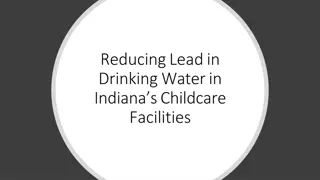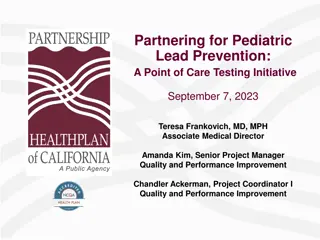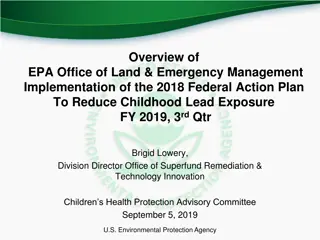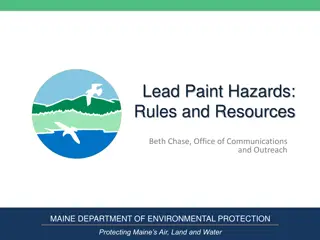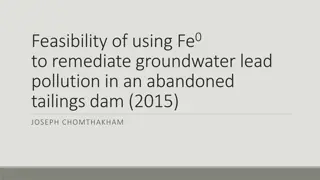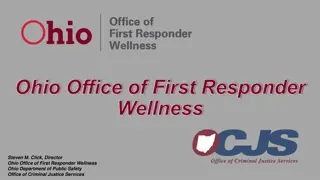Lead Awareness and Safety Training Overview
This training presentation provides valuable information on lead, including its properties, where it can be found, and occupational exposures. It discusses the risks associated with lead exposure and OSHA standards to ensure worker safety. The content covers essential topics such as what lead is, its uses, and how it affects workers in various industries. Understanding lead hazards and how to mitigate them is crucial for workplace safety and compliance with regulations.
Download Presentation

Please find below an Image/Link to download the presentation.
The content on the website is provided AS IS for your information and personal use only. It may not be sold, licensed, or shared on other websites without obtaining consent from the author.If you encounter any issues during the download, it is possible that the publisher has removed the file from their server.
You are allowed to download the files provided on this website for personal or commercial use, subject to the condition that they are used lawfully. All files are the property of their respective owners.
The content on the website is provided AS IS for your information and personal use only. It may not be sold, licensed, or shared on other websites without obtaining consent from the author.
E N D
Presentation Transcript
Lead Awareness and Safety Bureau of Workers Comp PA Training for Health & Safety (PATHS) 29 CFR 1910.1025 PPT-051-01 1
What is Lead? Heavy, bluish-gray metal Occurs naturally in the earth Usually combined with two or more elements to form a compound PPT-051-01 2
Properties Resistant to corrosion Easily molded and shaped Can be combined with other metals to form alloys PPT-051-01 3
Where do you find lead? Storage batteries Pigment for paints, dyes and ceramic glazes PPT-051-01 4
Where do you find lead? Pencils Ammunition PPT-051-01 5
Where do you find lead? Fishing sinkers Solder PPT-051-01 6
Occupational Exposures Demolition or salvage of structures PPT-051-01 7
Occupational Exposures Removal or encapsulation of materials PPT-051-01 8
Occupational Exposures New construction, alteration, repair or renovation of items PPT-051-01 9
Occupational Exposures Installation of materials Lead contamination or emergency cleanup PPT-051-01 10
Occupational Exposures Maintenance operation involving the disturbance of lead containing materials, or LCM Firing range operations PPT-051-01 11
OSHA Standard 29 CFR 1910.1025 Lead (c)(1) - The employer shall assure that no employee is exposed to lead at concentrations greater than 50mg/m3 (PEL) averaged over an 8 hour period (TWA) (d)(1)(i) - Employee exposure defined as that exposure that would occur if an employee were not wearing a respirator PPT-051-01 12
Exposure Commonly found in soil, especially near: Roadways Older houses Old orchards Mining areas Industrial sites PPT-051-01 13
Exposure Can also be found in soil near: Power plants Incinerators Landfills Hazardous waste sites PPT-051-01 14
Initial Determination (d)(1)(ii) - Employer must collect a full shift of personal samples, representative of monitored employee s regular, daily exposure to lead (d)(2) - Employer must determine if any employee may be exposed to lead at or above the action level PPT-051-01 15
Initial Monitoring (d)(4)(i) If positive determination is made where the possibility of an employee exposure is at or above the action level, the employer will conduct monitoring representative of each employee who is exposed to lead (d)(5) If negative determination is made where no employee exposure is at or above action level, the employer will make written record of it, to include date, location within the worksite, employee name and social security number who was monitored PPT-051-01 16
Employee Notification (d)(8) The employer must, within 15 working days, notify each affected employee of monitoring results either individually in writing or by posting the results in an appropriate location accessible to the employee PPT-051-01 17
Methods of Compliance (e)(1)(i) Where an employee is exposed to lead above the permissible exposure limit for more than 30 days per year, the employer shall implement engineering and work practice controls (including administrative controls) to reduce and maintain employee exposure (e)(2) Where engineering and work practice controls do not reduce employee exposure to below the permissible exposure level, the employer shall supplement these controls with respirators PPT-051-01 18
Compliance Program (e)(3)(i) Each employer shall establish and implement a written compliance program to reduce exposures to or below the permissible exposure limit (e)(3)(iv) Written programs must be revised and updated annually to remain current PPT-051-01 19
Compliance Program (e)(3)(ii) - Written program must have the following elements: Description of each operation in which lead is emitted What technology was used to determine need for this program Air monitoring data to document the source of emissions What engineering controls are used What work practice controls are used What administrative controls are used What respirators are provided Other relevant information PPT-051-01 20
Engineering Controls Mechanical ventilation (e)(4) Capture velocity Duct velocity Static pressure Measure effectiveness when production/process changes Recirculation of air HEPA filter with backup filter Controls to monitor concentration of lead in return air PPT-051-01 21
Work Practice Controls Housekeeping (h) All surfaces shall be maintained as free as practical from accumulations of lead Floors and surfaces where lead accumulates may not be cleaned by the use of compressed gas Vacuums shall be used and emptied in a manner which minimizes re-entry of lead into the workplace PPT-051-01 22
Work Practice Controls/PPE Use of protective work clothing (g) Coveralls or full-body work clothing Gloves, hats and shoes or disposable shoe coverlets Face shields or vented goggles PPT-051-01 23
Personal Protective Equipment In working with lead in any form, at a minimum, employees should wear gloves, either latex or leather, and safety goggles. Some tasks may require disposable coveralls, a half-face respirator with a HEPA filter and possibly steel-toed shoes. In all cases, wash hands immediately after working with lead. PPT-051-01 24
Maintaining PPE Employer shall repair/replace all equipment to maintain its effectiveness. Employer shall clean, launder or dispose of any damaged or contaminated clothing or equipment. PPT-051-01 25
Respiratory Protection -(f)(2) The employer must implement a respiratory protection program to cover each employee required to use a respirator. The employer must provide each employee with an appropriate respirator for the task/operation. Respirator must be used when installing or implementing engineering or work practice controls. Employee must go through a pulmonary function test and fit test for a respirator. Must provide HEPA filters for powered and non-powered respirators. PPT-051-01 26
Respiratory Protection Employers must provide employees with full face piece respirators for protection against lead aerosols that cause eye or skin irritations. Employers must provide employees with a powered air- purifying respirator (PAPR) instead of a negative pressure respirator when the employee chooses to use one and it provides adequate protection to the employee. PPT-051-01 27
Employees Responsibilities Employees will: Inform the supervisor of any respiratory hazards they believe are not adequately addressed. Receive instruction of workplace hazards requiring respiratory protection. Wear a respirator only after evaluated and approved by the HCP. Attend training in the proper use, wear, fit and maintenance of their respirator. Wear their respirator when and where it is required. Use, care for and maintain their respirator(s). PPT-051-01 28
Respirator Use Procedures Employees will use their respirators in accordance with the training they received. All respirators will be used according to their NIOSH certification. All respirator users will conduct positive or negative pressure seal checks each time they wear the respirator. Employees are not permitted to wear respirators if they have facial scars, facial hair, or missing dentures that prevent them from achieving a good seal. Employees are not permitted to wear headphones, jewelry or other items that may interfere with the seal. If a respirator malfunctions, employee should stop work, leave the area and report it to a supervisor. Work should not continue until a replacement respirator is obtained. PPT-051-01 29
Respirator Inspection Procedure Before using any respirator, employees will perform an inspection that includes the following items: Face piece (cracks, tears and holes; facemask distortion; cracked or loose lenses/face shield) Head straps (breaks or tears; broken buckles) Valves (residue or dirt; cracks or tears in valve material) Filters/cartridges (NIOSH approval designation; gaskets; cracks or dents in housing; proper cartridge for hazard) Respirators found to have defects will not be used. PPT-051-01 30
Change Rooms - (i)(2) The employer shall provide clean change rooms for employees who work in areas where the exposure to lead is above the PEL. The employer shall assure that change rooms are equipped with separate storage facilities for protective work clothing and for street clothes to prevent cross contamination. PPT-051-01 31
Showers (i)(3) Employer shall assure that employees who work in areas where exposure to lead is above PEL shower at the end of the work shift. Employees should not leave the workplace with any clothing or equipment worn during the work shift. PPT-051-01 32
Personal Hygiene Personal hygiene is critical in controlling lead exposure for employees. Hygiene facilities with soap, water and disposable towels must be provided for employees. Smoking, chewing tobacco, gum or food will not be allowed in the work area. Employees must wash their hands and face thoroughly before all breaks and at the end of the work shift. PPT-051-01 33
Lunchrooms - (i)(4) The employer shall provide lunchroom facilities for employees who work in areas where exposure to lead is above the PEL. Lunchroom must have controlled temperature, positive pressure, filtered air supply and be readily accessible to employees. PPT-051-01 34
Medical Surveillance (j)(1) Employer shall institute a program for all employees who may be exposed at or above action level for more than 30 days per year; and, Shall assure all medical exams and procedures are performed by a licensed physician; and, Shall provide exams without cost to the employee; and, Shall conduct a test every six months for blood, lead and zinc levels. PPT-051-01 35
Biological Monitoring- (j)(2) Shall conduct test every two months if blood sampling and analysis show an employee tested at or above 40 ug/100 g of whole blood, until two consecutive blood samples indicate blood lead level below 40 ug/100 g of whole blood Shall conduct test monthly on each employee removed from exposure to lead due to elevated blood lead level, with follow-up blood sampling two weeks after results of first test Laboratory must be licensed by CDC or USDOH PPT-051-01 36
Medical Examinations- (j)(3) Employer shall make available medical examinations and consultations to each employee: Annually for each employee with a blood sampling conducted during the preceding 12 months that indicated a blood lead level at or above 40 ug/100 g ASAP for an employee that has: Developed signs of lead intoxication, or Desires advice concerning the effects of exposure on his/her ability to have a child, or Has demonstrated difficulty breathing with a respirator PPT-051-01 37
Medical Examinations- (j)(3) Exams shall include: Detailed work history Medical history, with attention to past lead exposure(s), personal habits (smoking, hygiene) Any past gastrointestinal, hematologic, renal, cardiovascular, reproductive and neurological problems Thorough physical examination, attention to teeth, gums, systems listed above including pulmonary Blood pressure measurement Blood sample and analysis May include pregnancy testing or male fertility evaluation PPT-051-01 38
Medical Examinations- (j)(3) Multiple physician review mechanism If the employer selects the initial physician to conduct the medical exam/consultation, the employee may designate a second physician to review findings of the initial physician including conducting any additional exams deemed necessary. The employer notifies the employee of the right to a second opinion. The employee must inform the employer of intention to seek a second opinion and initiate steps to make that appointment within 15 days of initial physician s written opinion. PPT-051-01 39
Medical Examinations- (j)(3) If the two physicians differ, the employer will designate a third physician to review findings of both prior physicians to resolve the disagreement. The employer will act upon the findings of the third physician, unless employer and employee reach an agreement which is otherwise consistent with at least one of the three physicians. All medical opinions made by the physician(s) shall not be revealed to the employer in any means of communication. PPT-051-01 40
Medical Removal Protection-(k) Employer shall remove employees from work who have an exposure to lead each time the employee s blood lead level is at or above 60 ug/100 g of whole blood, and Employer shall remove employees from work having an exposure to lead at or above the action level that the average of the last three blood samplings conducted (or each sampling conducted over the previous six months) indicate a blood lead level at or above 50 [mu]g/100 g of whole blood Employer shall remove an employee from work when a final determination detects a medical condition of increased risk of material impairment to health. PPT-051-01 41
Return of Former Employee to Former Job Status-(k) The employer shall return an employee to his or her former job status when: Two consecutive blood samplings indicate the employee s blood lead level is below 40[mu]g/100 g of whole blood. A subsequent final determination no longer detects a medical condition of increased risk of material impairment to health. A subsequent final determination indicates that the limitations or special protective measures placed on an employee are no longer necessary. PPT-051-01 42
Medical Removal Protection Benefits Shall provide an employee up to 18 months of benefits on each occasion that employee is removed from exposure to lead Shall maintain the earnings, seniority and other employment rights of the employee as though the employee has not been removed Employee must participate in follow-up medical surveillance while removed If employee files a WC claim, employer shall continue to provide benefits pending disposition of claim If an award is made, the medical removal protection obligation will be reduced by that amount PPT-051-01 43
Medical Removal Protection Benefits If an employee s blood lead level does not adequately decline within 18 months of removal: Employer shall make a medical exam available to make a final determination. Shall assure the final determination indicates whether or not the employee may be returned to former job status If not, what steps should be taken to protect the health of the employee Shall continue to provide benefits until employee is returned to former job status, or is determined incapable to ever safely return to former job status PPT-051-01 44
Employee Information and Training- (l)(1) Training program: Employer shall institute a training program and ensure employee participation in the program. Shall provide initial training by 180 days from the effective date of those employees covered and prior to the time of initial job assignment Shall train employees who are subject to exposure to lead at or above the action level, or if the possibility of skin or eye irritation exists Shall repeat training at least annually for each employee PPT-051-01 45
Employee Information and Training- (l)(1) Employer shall assure each employee is informed of the following: The content of the lead standard and its appendices The specific nature of operations that could result in exposure to lead above the action level The purpose, proper selection, fitting, use and limitations of respirators The purpose and description of the medical surveillance program and the medical removal protection program The engineering controls and work practices associated with the job assignment The contents of any compliance program in effect PPT-051-01 46
Access to Information and Training Materials- (l)(2) The employer shall make readily available: A copy of this standard and its appendices to all affected employees All materials relating to the employee information and training program to the assistant secretary and the director (DOL-OSHA) Any materials pertaining to the Occupational Safety and Health Act as part of the training program PPT-051-01 47
Signs- (m) Employer shall post the following sign in each work area where the PEL is exceeded: Employer shall ensure that signs are illuminated and cleaned as necessary so that the legend is readily visible. PPT-051-01 48
Recordkeeping: Exposure Monitoring (n)(1) Employer shall establish and maintain an accurate record of all exposure monitoring. Employer shall maintain these records for 40 years or duration of employment plus 20 years, whichever is longer. PPT-051-01 49
Recordkeeping: Exposure Monitoring- (n)(1) This exposure monitoring record shall include: Date, number, duration, location and results of each of the samples taken, including a description of the sampling procedure used A description of the sampling and analytical methods used and evidence of their accuracy The type of respiratory devices worn, if any Name, SSN and job classification of the employee monitored and of all other employees whose exposure the measurement is intended to represent The environmental variables that could affect the measurement of employee exposure PPT-051-01 50




